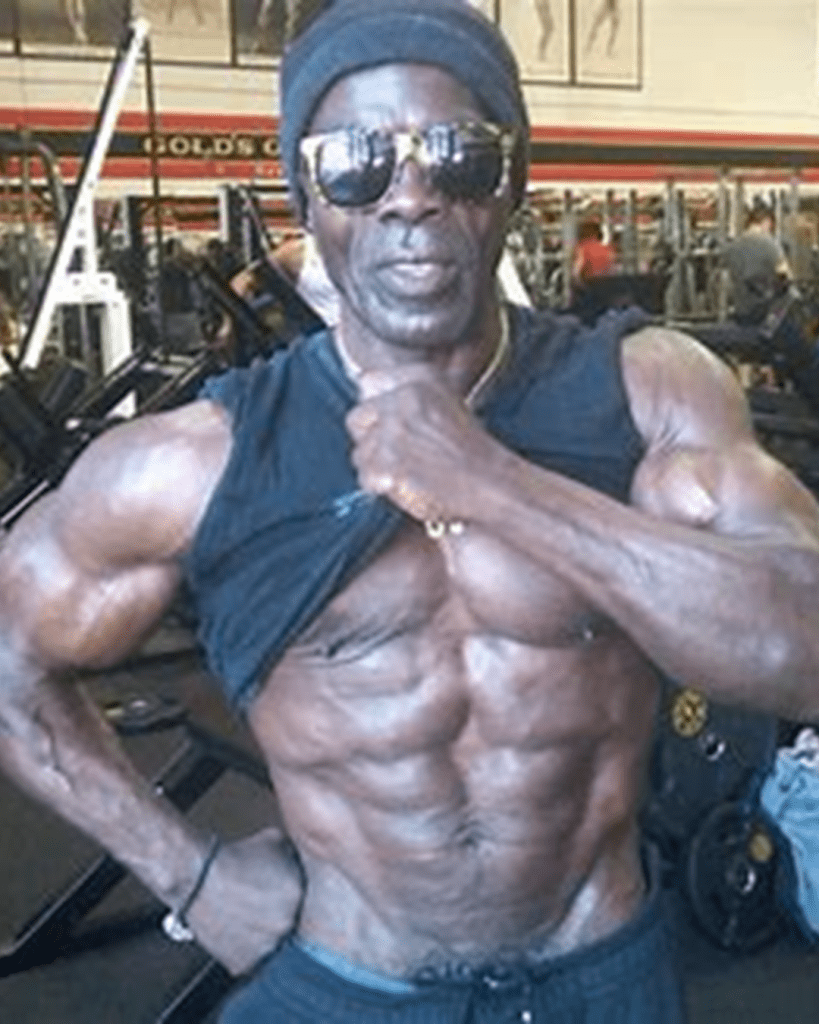“A journey of 1,000 miles begins with a single step.”
Lao Tzu
A super-ager is an age-defying older individual on the wrong side of 50, 60, 70 or 80 who has successfully revamped their physique. They’ve modified the body to a dramatic degree using a balanced combination of disparate disciplines. Physiologically, becoming a successful super-ager is challenging but doable – doable by a select disciplined few. Make no mistake: the methodology used to become a super-ager is harsh, hard, and uncompromising.
How do they do it? What magical methodology does the super-ager use to hold back the clichéd “hands of time?” The super-ager training and dietary strategy could be encapsulated as “the bodybuilding lifestyle.” Three disparate disciplines, combined expertly, leverage progress: intense resistance training is performed 4-6 times a week, cardiovascular exercise is done every day and twice a day during the final month of a lean-out phase, and exercise is always synchronized with a highly regimented and sympathetic dietary approach.
A super-ager is always working towards a physiological goal. These goals are attained by creating a sequential battle plan in which weekly performance and biometric benchmarks, ‘mini goals,’ are established and sequentially attained. The super-ager periodizes (preplans) everything: every set and rep, every cardio drill, every bite of food, every sip of liquid, sleep, and supplementation. Everything is pre-planned. Strategies within each discipline (lifting, aerobics, nutrition) get tweaked and adjusted every week, as needed.
 Robbie Robinson, age 75: how is this possible? Intense training + the expert use of regular food
Robbie Robinson, age 75: how is this possible? Intense training + the expert use of regular food
Elite super-agers achieve something far better than just holding back the hands of time—the true super-ager muscles the hands of time backward, using all-natural protocols and tactics. At a minimum, implementing super-ager strategies slows bodily degradation, and when done in extremis, the super-ager procedures factually reverse the aging process.
Impossible? Maybe for you – but not for Robbie Robinson, John Citrone, Dr. Ken Davis, or Marty Gallagher, each man a bona fide super-ager. Robbie and John were bodybuilding legends at age 25 and never allowed themselves to get out of shape. Dr. Ken, age 72, got a late start and made up for lost time in sensational fashion. Marty Gallagher, age 74, is a legendary figure in powerlifting and strength athletics, possessing an age-defying physique using methods quite opposite those of Robbie, John, and Ken.
Dr. Ken Davis makes for an interesting case study in that he became an elite anti-ager late in life, unlike Robinson, Citrone, or Gallagher. Those men had 60 years of deep immersion in ‘the process.’ He started his bodybuilding journey at age 66. His progress has been dramatic and documented every step of the way.
“When I started bodybuilding, I was in good general shape for a typical man my age.” As someone who taught health and wellness, Davis walked the walk. “At age 66, I had good blood profiles and was in the below-average body fat percentile. I performed cardio exercise every week and was in good physical shape.”
By chance, Ken became exposed to the odd and eclectic world of competitive bodybuilding and decided to immerse himself in this strange universe. Davis was smart; he knew himself. “From the start, I was determined to compete; I work best under pressure. By competing, I was putting myself on the spot. It made it easier to follow the strict tenants and uncompromising commandments of bodybuilding. My incentive was knowing that I would be striding onstage in a few short months, to be judged on my physique.” That was a powerful motivation.
At age 66, Ken began weight training for the first time. He muscled up quickly and dramatically. When he commenced bodybuilding, he weighed a few biscuits shy of 240 pounds. By combining daily cardiovascular exercise with a “super-clean” bodybuilder diet, Davis shed 25 pounds of body fat by the end of his first year of “full-on commitment.”
Ken competed in his first bodybuilding competition nine months after launching his career. Six years later, Dr. Ken captured the IFBB world championship in his age group and weight class. His progress over his first six years is well-documented, visually and medically. Ken uses a myriad of performance and medical biometric benchmarks to measure the effectiveness of his training and nutritional and supplemental protocols. He makes weekly tweaks and adjustments based on the hard data.
Davis not only held back the hands of time, he pulled those hands of time backward. The 72-year-old Davis is indisputably fitter, leaner, more muscled up, has far better blood profiles, and vastly improved strength and endurance personal records than the not-out-of-shape 66-year-old Davis. Competitive bodybuilders, men over 50, 60, 70 or 80, have discovered a fountain of youth. These chronologic oldsters may have high mileage on the odometer – yet their physiques are age-defying and downright mind-blowing.
The super-ager is not an isolated phenomenon, confined geographically to southern California, for instance. There is a worldwide proliferation of super-agers. These men are found all over the globe. Once a man becomes an elite elder bodybuilder, they are already a super-ager. The strategies that Robinson, Citrone, Davis, and Gallagher adhere to are identical while diverging in the specifics.
 English bodybuilding legend John Citrone, at age 70
English bodybuilding legend John Citrone, at age 70
Robbie, John, and Ken are high-volume competitive bodybuilders, while Gallagher is a max-intensity, purposefully minimalist strength athlete. To quote Marty, “Many roads lead to super-ager Rome…and all those roads are winding, grueling, and difficult.” The methodologies and protocols used by high-level bodybuilders unintendedly created the super-ager.
Bodybuilders are the masters of body composition manipulation. The foundational discipline of bodybuilding is not lifting weights or cardiovascular exercise—the soul of bodybuilding is nutrition. Adhering to a strict bodybuilding-style nutritional approach requires a steel mind and iron discipline: smaller meals are consumed at equidistant intervals throughout the day. The food is high quality and confined to “clean calories” like lean protein, MCT lipids, fibrous carbohydrates, and complex starch carbs. Only quality calories are consumed. Supplements are supplemental.

The super-ager is all about the expert use of regular food. Here is a typical dietary day in the life of a competitive super-ager bodybuilder. This is not the competition prep phase; this is the mass-building off-season phase.
5 am Awake – drink 16-32 ounces of water (two gallons daily)
7 am Post-cardio – beef patty, whole egg omelet with diced vegetables, Ezekiel bread
10 am Mid-morning – oatmeal, protein shake, sports nutrition bar
1 pm Lunch – turkey burgers w/lettuce, tomato, mayo on Ezekiel bread, garden salad
4 pm Pre-workout – ground lamb/diced vegetable/rice mixture, energy drink, or coffee
6:30 pm Dinner – salad, grilled salmon, coleslaw, sweet potato fries (in MCT oil)
9 pm Snack – protein shake, sports nutrition bar
In the off-season, the goal is to grow lean muscle mass. To fuel muscle growth, eat big—but still eat clean. In the off-season, feel free to go out to a restaurant on a weekend night and eat whatever, including drinks and dessert—just be sure to get back on the clean calorie bandwagon the following day. The competitive off-season is any time other than the 12-16 weeks before a competition.
Leading up to a bodybuilding competition, the bodybuilder shifts gears: now, the game is to melt off body fat. To that end, the training volume is increased, the calories decreased, starch intake whittled down, and twice-a-day cardio. The prep phase is the “strain and starve” phase designed with one goal: strip away body fat with a 12-week deadline—no more cheat days.

The competitive bodybuilder swings back and forth between off-season phases of adding mass – without adding an unacceptable amount of body fat – or phases of getting as lean as possible – without losing an unacceptable amount of hard-earned off-season muscle. A typical, off-season mass-building resistance training program (for a super-ager) would last 45-60 minutes. Cardio might be confined to thrice weekly on non-lifting days – though most super-agers love to start every single day with “fasted” (before breakfast) cardio.
Day 1 Legs: smith machine squats, leg extensions, seated leg curls, calf raises, abs
Day 2 Chest & arms: bench press, incline press, pec deck, seated DB curls, dips, cable curl, pushdowns
Day 3 Off cardio – 30 minutes at 80%
Day 4 Back: deadlift, power clean, shrug, lat pulldown, seated rows
Day 5 Shoulders: seated dumbbell press, machine press, side laterals, cable laterals, bent-over rear laterals
Day 6 Off cardio – 35 minutes at 80%
Day 7 Off cardio – 40 minutes at 80%
In a 10-week off-season mass-building phase, a 200-pound bodybuilder might seek to add one pound of scale weight per week for ten successive weeks—210 being the final bodyweight goal. No faster, no slower. Any faster runs the risk of adding an unacceptable amount of body fat. The challenge is to eat enough clean calories to push body weight upward at a methodical pace, not too fast or slow, for ten straight weeks, come hell or high water. Easy at the start, hard at the finish.
The most critical aspect of “the process” is adherence: super-agers know that tangible results generate enthusiasm, and enthusiasm is mental fuel that refires the effort. Enthusiasm creates (effortless) adherence with ever-increasing degrees of strictness and intensity. The key to triggering measurable physiological results on a consistent and ongoing basis is having a valid three-pronged battle plan and then executing it with a controlled ferocity born of actual, measurable, tangible, visible physiological results. Real results create genuine enthusiasm, and enthusiasm regenerates effortless and tenacious adherence. Round and round it goes. Super-agers call it the ‘metabolic sweet spot.’






0 Comments